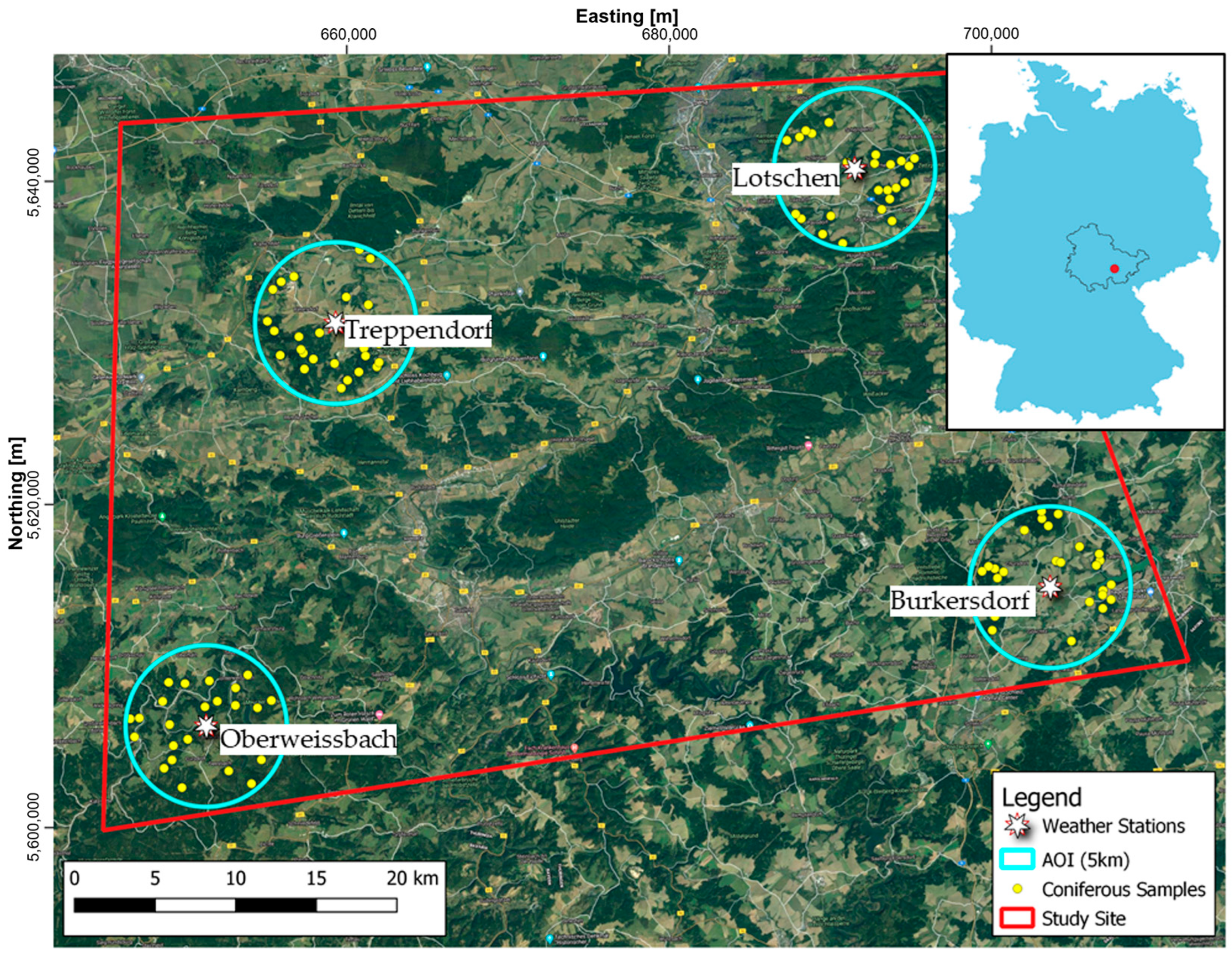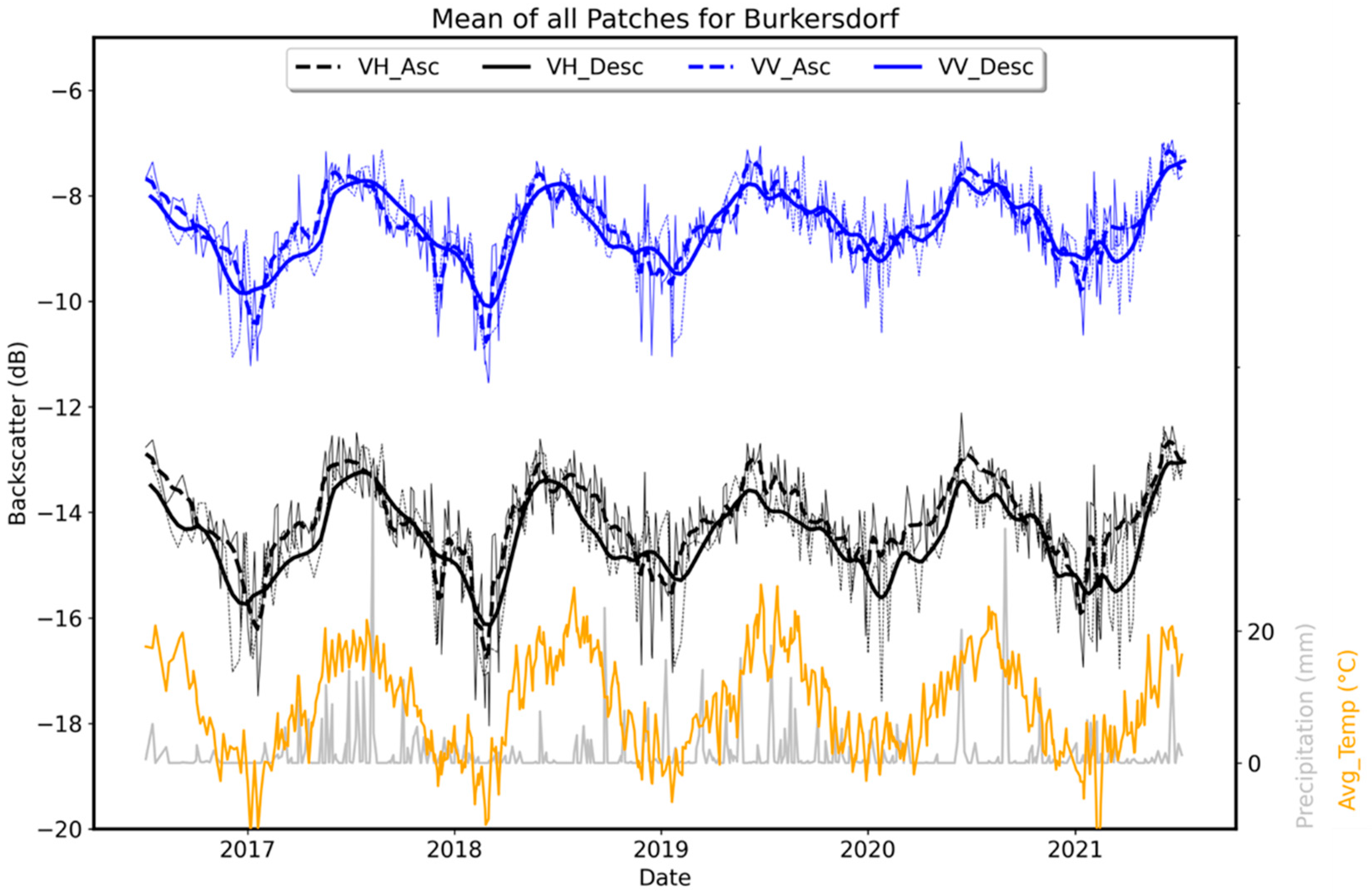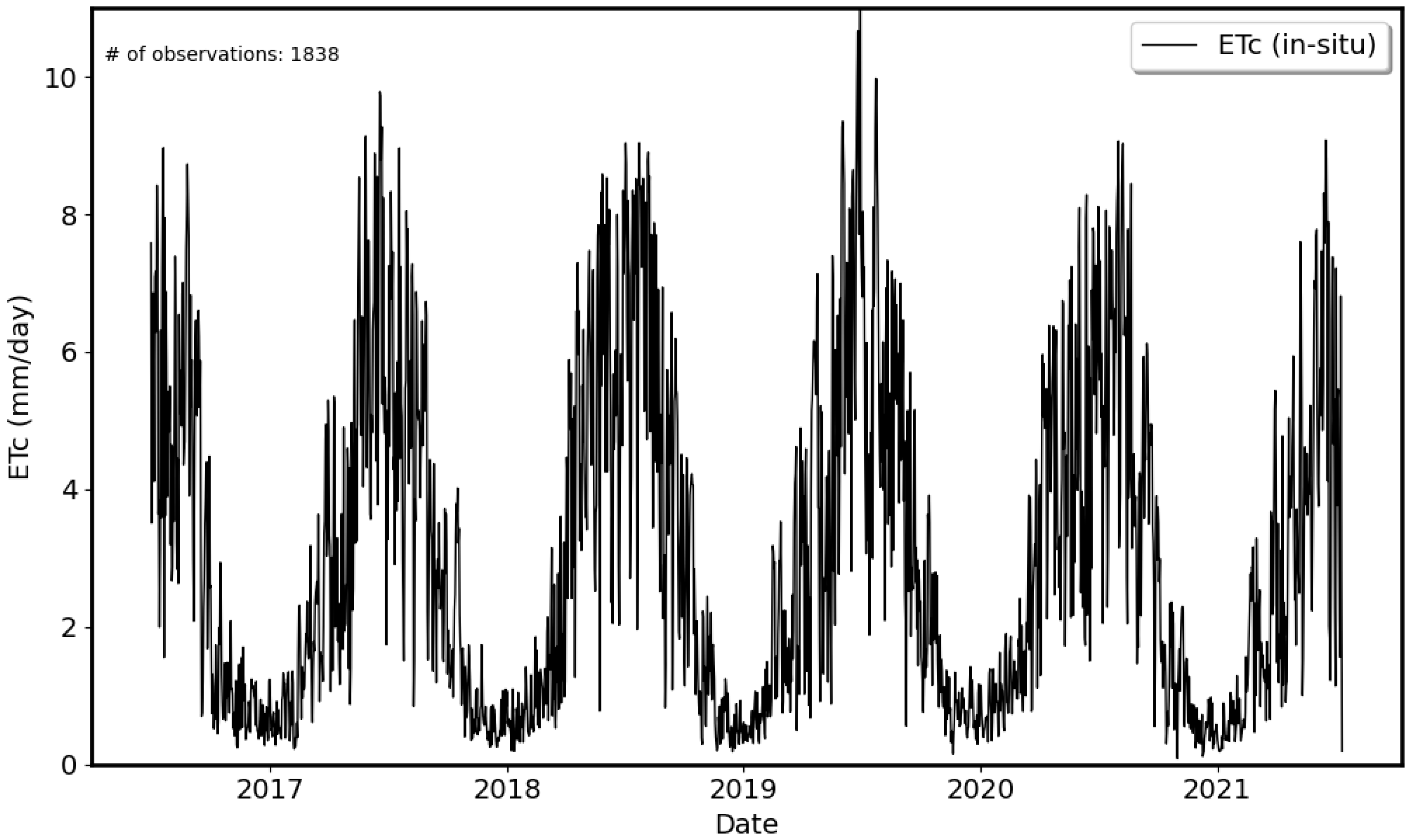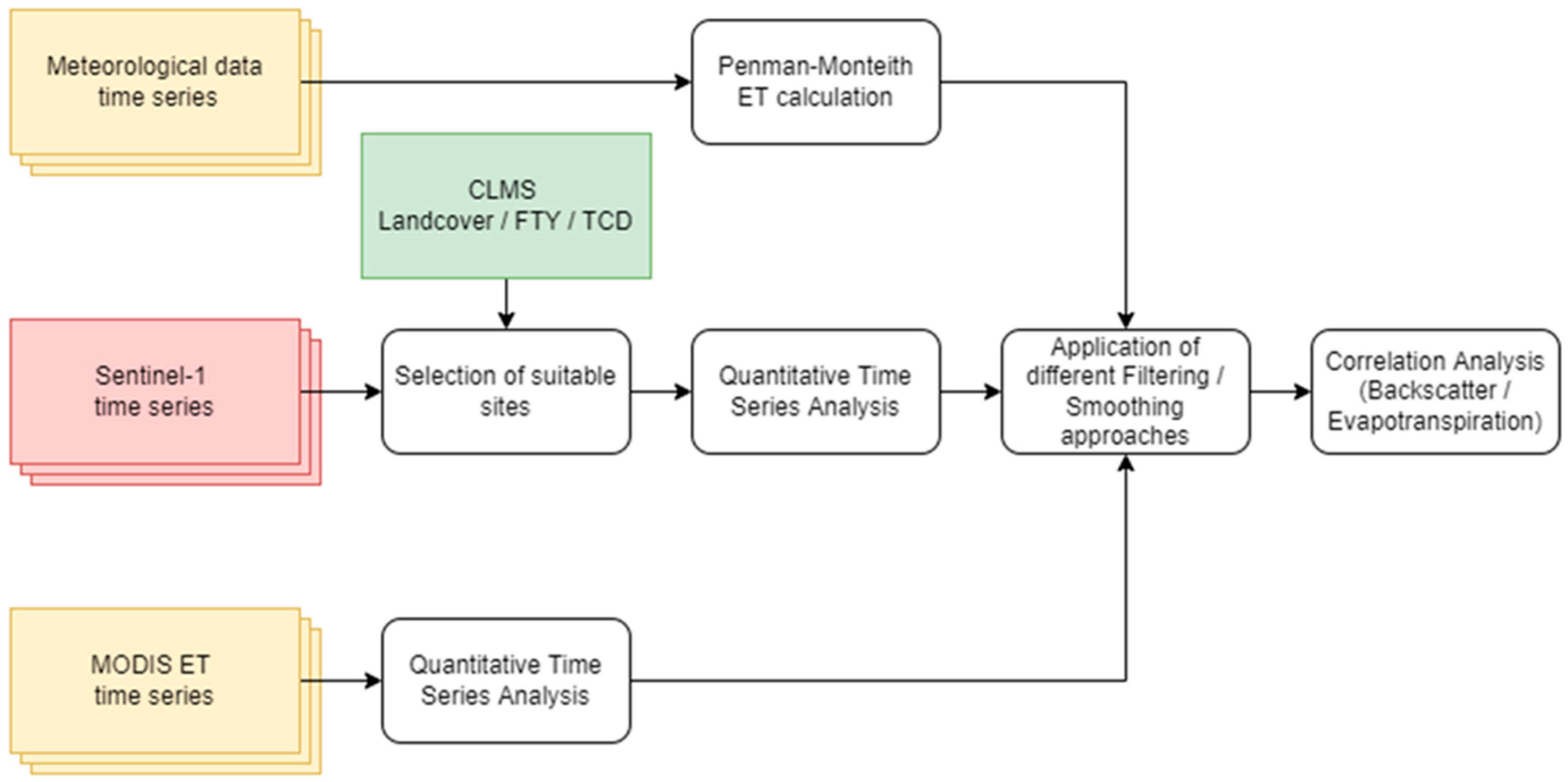Sentinel-1 Backscatter Time Series for Characterization of Evapotranspiration Dynamics over Temperate Coniferous Forests
Abstract
:1. Introduction
2. Materials and Study Site
2.1. Study Site
2.2. Datasets
2.2.1. Sentinel-1 Time Series
2.2.2. Terra/Aqua MODIS ET Time Series
2.2.3. In Situ Meteorological Data
2.2.4. Auxiliary Datasets
3. Methods
3.1. Data Selection
3.2. SAR Time Series Preprocessing
3.3. ET Time Series Preprocessing
4. Results and Discussion
4.1. Sentinel-1 Backscatter Time Series
4.2. Evapotranspiration Time Series
4.3. Sentinel-1 Backscatter vs. Evapotranspiration
5. Conclusions
Author Contributions
Funding
Conflicts of Interest
References
- Gower, S.T. Patterns and Mechanisms of the Forest Carbon Cycle. Annu. Rev. Environ. Resour. 2003, 28, 169–204. [Google Scholar] [CrossRef]
- Dong, J.; Kaufmann, R.K.; Myneni, R.B.; Tucker, C.J.; Kauppi, P.E.; Liski, J.; Buermann, W.; Alexeyev, V.; Hughes, M.K. Remote sensing estimates of boreal and temperate forest woody biomass: Carbon pools, sources, and sinks. Remote Sens. Environ. 2003, 84, 393–410. [Google Scholar] [CrossRef] [Green Version]
- Goodale, C.L.; Apps, M.J.; Birdsey, R.A.; Field, C.B.; Heath, L.S.; Houghton, R.A.; Jenkins, J.C.; Kohlmaier, G.H.; Kurz, W.; Liu, S.; et al. Forest carbon sinks in the northern hemisphere. Ecol. Appl. 2002, 12, 891–899. [Google Scholar] [CrossRef]
- Proisy, C.; Mougin, E.; Dufrene, E.; Le Dantec, V. Monitoring seasonal changes of a mixed temperate forest using ERS SAR observations. IEEE Trans. Geosci. Remote Sens. 2000, 38, 540–552. [Google Scholar] [CrossRef]
- Friedlingstein, P.; Jones, M.W.; O’Sullivan, M.; Andrew, R.M.; Hauck, J.; Peters, G.P.; Peters, W.; Pongratz, J.; Sitch, S.; Le Quéré, C.; et al. Global Carbon Budget 2019. Earth Syst. Sci. Data 2019, 11, 1783–1838. [Google Scholar] [CrossRef] [Green Version]
- ThüringenForst. Der Wald der Zukunft in Thüringen: Herausforderungen und Lösungen am Beispiel des Staatswaldes. Available online: https://www.thueringenforst.de/fileadmin/user_upload/Download/WaldWissen/Wald-der-Zukunft_Handout-Pressegespraech.pdf (accessed on 1 November 2021).
- Wenzel, A.; Frischbier, N.; Jürgen, S.; Wittau, F. Bundeswaldinventur 3 im Freistaat Thüringen: Mitteilungen 34/2015, 1st ed.; ThüringenForst: Erfurt, Germany, 2015; ISBN 2196-6087. [Google Scholar]
- Huete, A.R. Vegetation Indices, Remote Sensing and Forest Monitoring. Geogr. Compass 2012, 6, 513–532. [Google Scholar] [CrossRef]
- Anderegg, W.R.L.; Konings, A.G.; Trugman, A.T.; Yu, K.; Bowling, D.R.; Gabbitas, R.; Karp, D.S.; Pacala, S.; Sperry, J.S.; Sulman, B.N.; et al. Hydraulic diversity of forests regulates ecosystem resilience during drought. Nature 2018, 561, 538–541. [Google Scholar] [CrossRef] [Green Version]
- Avetisyan, D.; Borisova, D.; Velizarova, E. Integrated Evaluation of Vegetation Drought Stress through Satellite Remote Sensing. Forests 2021, 12, 974. [Google Scholar] [CrossRef]
- Sturm, J.; Santos, M.J.; Schmid, B.; Damm, A. Satellite data reveal differential responses of Swiss forests to unprecedented 2018 drought. Glob. Chang. Biol. 2022, 28, 2956–2978. [Google Scholar] [CrossRef]
- Gazol, A.; Camarero, J.J.; Vicente-Serrano, S.M.; Sánchez-Salguero, R.; Gutiérrez, E.; de Luis, M.; Sangüesa-Barreda, G.; Novak, K.; Rozas, V.; Tíscar, P.A.; et al. Forest resilience to drought varies across biomes. Glob. Chang. Biol. 2018, 24, 2143–2158. [Google Scholar] [CrossRef]
- Min, Q.; Lin, B. Remote sensing of evapotranspiration and carbon uptake at Harvard Forest. Remote Sens. Environ. 2006, 100, 379–387. [Google Scholar] [CrossRef] [Green Version]
- Guzinski, R.; Nieto, H. Evaluating the feasibility of using Sentinel-2 and Sentinel-3 satellites for high-resolution evapotranspiration estimations. Remote Sens. Environ. 2019, 221, 157–172. [Google Scholar] [CrossRef]
- Guzinski, R.; Nieto, H.; Sandholt, I.; Karamitilios, G. Modelling High-Resolution Actual Evapotranspiration through Sentinel-2 and Sentinel-3 Data Fusion. Remote Sens. 2020, 12, 1433. [Google Scholar] [CrossRef]
- Zhang, K.; Kimball, J.S.; Running, S.W. A review of remote sensing based actual evapotranspiration estimation. WIRES Water 2016, 3, 834–853. [Google Scholar] [CrossRef]
- Monteith, J.L. Evaporation and environment. Symp. Soc. Exp. Biol. 1965, 19, 205–234. [Google Scholar]
- Liou, Y.-A.; Kar, S. Evapotranspiration Estimation with Remote Sensing and Various Surface Energy Balance Algorithms—A Review. Energies 2014, 7, 2821–2849. [Google Scholar] [CrossRef] [Green Version]
- Verstraeten, W.W.; Veroustraete, F.; Feyen, J. Assessment of Evapotranspiration and Soil Moisture Content Across Different Scales of Observation. Sensors 2008, 8, 70–117. [Google Scholar] [CrossRef] [Green Version]
- Talsma, C.J.; Good, S.P.; Jimenez, C.; Martens, B.; Fisher, J.B.; Miralles, D.G.; McCabe, M.F.; Purdy, A.J. Partitioning of evapotranspiration in remote sensing-based models. Agric. For. Meteorol. 2018, 260–261, 131–143. [Google Scholar] [CrossRef]
- WMO. The Global Observing System for Climate: Implementation Needs: GCOS-200. Available online: https://library.wmo.int/doc_num.php?explnum_id=3417 (accessed on 15 May 2022).
- Allen, R.G. Assessing Integrity of Weather Data for Reference Evapotranspiration Estimation. J. Irrig. Drain. Eng. 1996, 122, 97–106. [Google Scholar] [CrossRef]
- Monin, A.S.; Obukhov, A.M. Basic laws of turbulent mixing in the surface layer of the atmosphere. Geophys. Inst. Acad. Sci. 1954, 24, 163–187. [Google Scholar]
- Penman, H.L. Natural evaporation from open water, hare soil and grass. Proc. R. Soc. Lond. A Math. Phys. Sci. 1948, 193, 120–145. [Google Scholar] [CrossRef] [PubMed] [Green Version]
- Allen, R.G. Crop Evapotranspiration: Guidelines for Computing Crop Water Requirements; Repr; Food and Agriculture Organization of the United States: Rome, Italy, 2002; ISBN 9251042195. [Google Scholar]
- Cleugh, H.A.; Leuning, R.; Mu, Q.; Running, S.W. Regional evaporation estimates from flux tower and MODIS satellite data. Remote Sens. Environ. 2007, 106, 285–304. [Google Scholar] [CrossRef]
- Running, S.W.; Mu, Q.; Zhao, M.; Morena, A. User’s Guide MODIS Global Terrestrial Evapotranspiration (ET) Product (MOD16A2/A3 and Year-end Gap-Filled MOD16A2GF/A3GF) NASA Earth Observing System MODIS Land Algorithm (For Collection 6). Available online: https://lpdaac.usgs.gov/documents/494/MOD16_User_Guide_V6.pdf (accessed on 14 October 2021).
- Amazirh, A.; Merlin, O.; Er-Raki, S.; Gao, Q.; Rivalland, V.; Malbeteau, Y.; Khabba, S.; Escorihuela, M.J. Retrieving surface soil moisture at high spatio-temporal resolution from a synergy between Sentinel-1 radar and Landsat thermal data: A study case over bare soil. Remote Sens. Environ. 2018, 211, 321–337. [Google Scholar] [CrossRef]
- Amazirh, A.; Merlin, O.; Er-Raki, S. Including Sentinel-1 radar data to improve the disaggregation of MODIS land surface temperature data. ISPRS J. Photogramm. Remote Sens. 2019, 150, 11–26. [Google Scholar] [CrossRef]
- El-Shirbeny, M.A.; Saleh, S.M. Actual evapotranspiration evaluation based on multi-sensed data. JAA 2021, 7, 95–102. [Google Scholar] [CrossRef]
- Chintala, S.; Harmya, T.S.; Kambhammettu, B.; Moharana, S.; Duvvuri, S. Modelling high-resolution Evapotranspiration in fragmented croplands from the constellation of Sentinels. Remote Sens. Appl. Soc. Environ. 2022, 26, 100704. [Google Scholar] [CrossRef]
- Zappa, L.; Schlaffer, S.; Bauer-Marschallinger, B.; Nendel, C.; Zimmerman, B.; Dorigo, W. Detection and Quantification of Irrigation Water Amounts at 500 m Using Sentinel-1 Surface Soil Moisture. Remote Sens. 2021, 13, 1727. [Google Scholar] [CrossRef]
- El-Shirbeny, M.A.; Abutaleb, K. Sentinel-1 Radar Data Assessment to Estimate Crop Water Stress. WJET 2017, 05, 47–55. [Google Scholar] [CrossRef] [Green Version]
- Nasrallah, A.; Baghdadi, N.; El Hajj, M.; Darwish, T.; Belhouchette, H.; Faour, G.; Darwich, S.; Mhawej, M. Sentinel-1 Data for Winter Wheat Phenology Monitoring and Mapping. Remote Sens. 2019, 11, 2228. [Google Scholar] [CrossRef] [Green Version]
- Dubois, C.; Mueller, M.M.; Pathe, C.; Jagdhuber, T.; Cremer, F.; Thiel, C.; Schmullius, C. Characterization of land cover seasonality in sentinel-1 time series data. ISPRS Ann. Photogramm. Remote Sens. Spatial Inf. Sci. 2020, V-3-2020, 97–104. [Google Scholar] [CrossRef]
- EEA CLMS. Corine Land Cover 2018. Available online: https://land.copernicus.eu/pan-european/corine-land-cover/clc2018 (accessed on 10 October 2021).
- EEA CLMS. Tree Cover Density 2018. Available online: https://land.copernicus.eu/pan-european/high-resolution-layers/forests/tree-cover-density/status-maps/tree-cover-density-2018 (accessed on 11 October 2021).
- TLBG. Download Höhendaten (DGM/DOM/LAZ). Available online: https://www.geoportal-th.de/de-de/Downloadbereiche/Download-Offene-Geodaten-Th%C3%BCringen/Download-H%C3%B6hendaten (accessed on 12 October 2021).
- DWD. Niederschlag: Vieljährige Mittelwerte 1961–1990. Available online: https://www.dwd.de/DE/leistungen/klimadatendeutschland/mittelwerte/nieder_6190_akt_html (accessed on 28 October 2021).
- TLUBN. Klimabericht Dezember 2020 und Jahr 2020. Available online: https://tlubn.thueringen.de/fileadmin/00_tlubn/Klima/Dokumente/Klimabericht/Klimabericht_Monat_Dezember_Jahr_2020.pdf (accessed on 26 October 2021).
- EEA CLMS. Forest Type 2018. Available online: https://land.copernicus.eu/pan-european/high-resolution-layers/forests/forest-type-1/status-maps/forest-type-2018 (accessed on 12 October 2021).
- EEA CLMS. Copernicus Land Monitoring Service. Available online: https://land.copernicus.eu/ (accessed on 30 October 2021).
- Schwerdt, M.; Schmidt, K.; Tous Ramon, N.; Klenk, P.; Yague-Martinez, N.; Prats-Iraola, P.; Zink, M.; Geudtner, D. Independent System Calibration of Sentinel-1B. Remote Sens. 2017, 9, 511. [Google Scholar] [CrossRef] [Green Version]
- Truckenbrodt, J.; Cremer, F.; Baris, I.; Eberle, J. pyroSAR—A Framework for Large-Scale SAR Satellite Data Processing. In Proceedings of the 2019 Living Planet Symposium, Milan, Italy, 13–17 May 2019. [Google Scholar]
- Mueller, M.M.; Dubois, C.; Jagdhuber, T.; Pathe, C.; Schmullius, C. Investigation of sentinel-1 time series for sensitivity to fern vegetation in an european temperate forest. Int. Arch. Photogramm. Remote Sens. Spatial Inf. Sci. 2021, XLIII-B3-2021, 127–134. [Google Scholar] [CrossRef]
- Running, S.W.; Mu, Q.; Zhao, M. MOD16A2 MODIS/Terra Net Evapotranspiration 8-Day L4 Global 500m SIN Grid V006; NASA LP DAAC: Sioux Falls, SD, USA, 2017. [Google Scholar]
- Crosson, W.L.; Al-Hamdan, M.Z.; Hemmings, S.N.; Wade, G.M. A daily merged MODIS Aqua–Terra land surface temperature data set for the conterminous United States. Remote Sens. Environ. 2012, 119, 315–324. [Google Scholar] [CrossRef]
- TLLLR. Agrarmeteorologie Thüringen—Stationskarte. Available online: https://www.wetter-th.de/Agrarmeteorologie-TH/Wetterdaten/Stationskarte (accessed on 20 October 2021).
- Friesen, J.; Steele-Dunne, S.C.; van de Giesen, N. Diurnal Differences in Global ERS Scatterometer Backscatter Observations of the Land Surface. IEEE Trans. Geosci. Remote Sens. 2012, 50, 2595–2602. [Google Scholar] [CrossRef]
- Steele-Dunne, S.C.; Friesen, J.; van de Giesen, N. Using Diurnal Variation in Backscatter to Detect Vegetation Water Stress. IEEE Trans. Geosci. Remote Sens. 2012, 50, 2618–2629. [Google Scholar] [CrossRef]
- Vaiphasa, C. Consideration of smoothing techniques for hyperspectral remote sensing. ISPRS J. Photogramm. Remote Sens. 2006, 60, 91–99. [Google Scholar] [CrossRef]
- D’Arcy, J. Introducing SSA for Time Series Decomposition. Available online: https://www.kaggle.com/jdarcy/introducing-ssa-for-time-series-decomposition (accessed on 15 August 2021).
- Golyandina, N.; Nekrutkin, V.V.; Žigljavskij, A.A. Analysis of Time Series Structure: SSA and Related Techniques; Chapman & Hall/CRC: Boca Raton, FL, USA, 2001; ISBN 1584881941. [Google Scholar]
- Trenberth, K.E. What are the Seasons? Bull. Amer. Meteor. Soc. 1983, 64, 1276–1282. [Google Scholar] [CrossRef]
- Dostálová, A.; Lang, M.; Ivanovs, J.; Waser, L.T.; Wagner, W. European Wide Forest Classification Based on Sentinel-1 Data. Remote Sens. 2021, 13, 337. [Google Scholar] [CrossRef]
- Rüetschi, M.; Schaepman, M.; Small, D. Using Multitemporal Sentinel-1 C-band Backscatter to Monitor Phenology and Classify Deciduous and Coniferous Forests in Northern Switzerland. Remote Sens. 2018, 10, 55. [Google Scholar] [CrossRef] [Green Version]
- Kurum, M.; Lang, R.H.; O’Neill, P.E.; Joseph, A.T.; Jackson, T.J.; Cosh, M.H. L-Band Radar Estimation of Forest Attenuation for Active/Passive Soil Moisture Inversion. IEEE Trans. Geosci. Remote Sens. 2009, 47, 3026–3040. [Google Scholar] [CrossRef]
- Monteith, A.R.; Ulander, L.M.H. Temporal Characteristics of P-Band Tomographic Radar Backscatter of a Boreal Forest. IEEE J. Sel. Top. Appl. Earth Obs. Remote Sens. 2021, 14, 1967–1984. [Google Scholar] [CrossRef]
- van Emmerik, T.; Steele-Dunne, S.; Paget, A.; Oliveira, R.S.; Bittencourt, P.R.L.; Barros, F.d.V.; van de Giesen, N. Water stress detection in the Amazon using radar. Geophys. Res. Lett. 2017, 44, 6841–6849. [Google Scholar] [CrossRef]
- DWD. Niederschlag: Vieljährige Mittelwerte 1981–2010. Available online: https://www.dwd.de/DE/leistungen/klimadatendeutschland/mittelwerte/nieder_8110_akt_html (accessed on 9 October 2021).
- Khabbazan, S.; Steele-Dunne, S.C.; Vermunt, P.; Judge, J.; Vreugdenhil, M.; Gao, G. The influence of surface canopy water on the relationship between L-band backscatter and biophysical variables in agricultural monitoring. Remote Sens. Environ. 2022, 268, 112789. [Google Scholar] [CrossRef]
- Vermunt, P.C.; Khabbazan, S.; Steele-Dunne, S.C.; Judge, J.; Monsivais-Huertero, A.; Guerriero, L.; Liu, P.-W. Response of Subdaily L-Band Backscatter to Internal and Surface Canopy Water Dynamics. IEEE Trans. Geosci. Remote Sens. 2021, 59, 7322–7337. [Google Scholar] [CrossRef]
- Koyama, C.N.; Watanabe, M.; Hayashi, M.; Ogawa, T.; Shimada, M. Mapping the spatial-temporal variability of tropical forests by ALOS-2 L-band SAR big data analysis. Remote Sens. Environ. 2019, 233, 111372. [Google Scholar] [CrossRef]
- Shimada, M.; Itoh, T.; Motooka, T.; Watanabe, M.; Shiraishi, T.; Thapa, R.; Lucas, R. New global forest/non-forest maps from ALOS PALSAR data (2007–2010). Remote Sens. Environ. 2014, 155, 13–31. [Google Scholar] [CrossRef]
- Jagdhuber, T.; Fluhrer, A.; Schmidt, A.-S.; Jonard, F.; Chaparro, D.; Meyer, T.; Holtzman, N.; Konings, A.G.; Feldman, A.; Baur, M.; et al. Retrieval of Forest Water Potential from L-Band Vegetation Optical Depth. In Proceedings of the IGARSS 2021—2021 IEEE International Geoscience and Remote Sensing Symposium, Brussels, Belgium, 11–16 July 2021; pp. 5949–5952, ISBN 978-1-6654-0369-6. [Google Scholar]
- Thiel, C.; Mueller, M.M.; Berger, C.; Cremer, F.; Dubois, C.; Hese, S.; Baade, J.; Klan, F.; Pathe, C. Monitoring Selective Logging in a Pine-Dominated Forest in Central Germany with Repeated Drone Flights Utilizing a Low Cost RTK Quadcopter. Drones 2020, 4, 11. [Google Scholar] [CrossRef] [Green Version]
- Justus, C.G.; Mikhail, A. Height variation of wind speed and wind distributions statistics. Geophys. Res. Lett. 1976, 3, 261–264. [Google Scholar] [CrossRef]
- Monteith, A.R.; Ulander, L.M.H. Temporal Survey of P- and L-Band Polarimetric Backscatter in Boreal Forests. IEEE J. Sel. Top. Appl. Earth Obs. Remote Sens. 2018, 11, 3564–3577. [Google Scholar] [CrossRef] [Green Version]
- Steele-Dunne, S.C.; McNairn, H.; Monsivais-Huertero, A.; Judge, J.; Liu, P.-W.; Papathanassiou, K. Radar Remote Sensing of Agricultural Canopies: A Review. IEEE J. Sel. Top. Appl. Earth Obs. Remote Sens. 2017, 10, 2249–2273. [Google Scholar] [CrossRef] [Green Version]
- Petchiappan, A.; Steele-Dunne, S.C.; Vreugdenhil, M.; Hahn, S.; Wagner, W.; Oliveira, R. The influence of vegetation water dynamics on the ASCAT backscatter–incidence angle relationship in the Amazon. Hydrol. Earth Syst. Sci. 2022, 26, 2997–3019. [Google Scholar] [CrossRef]
- Boegh, E.; Poulsen, R.N.; Butts, M.; Abrahamsen, P.; Dellwik, E.; Hansen, S.; Hasager, C.B.; Ibrom, A.; Loerup, J.-K.; Pilegaard, K.; et al. Remote sensing based evapotranspiration and runoff modeling of agricultural, forest and urban flux sites in Denmark: From field to macro-scale. J. Hydrol. 2009, 377, 300–316. [Google Scholar] [CrossRef]







| Dataset | Flight Direction | Relative Orbit | Incidence Angle | No. of Acquisitions | Time of Acquisition (UTC) | Acquisition Period |
|---|---|---|---|---|---|---|
| 1 | Descending | 168 | 37.7°–41.3° | 225 | 05:25 | 07/14/2016–07/12/2021 |
| 2 | Ascending | 44 | 33.2°–37.4° | 270 | 16:59 | 07/05/2016–06/27/2021 |
| 3 | Ascending | 117 | 42.2°–45.5° | 262 | 17:08 | 07/17/2016–07/08/2021 |
| R-Squared | ||||
|---|---|---|---|---|
| SMA (ws = 10) | Burkersdorf | Lotschen | Oberweissbach | Treppendorf |
| S1 ascending | 0.796 | 0.795 | 0.782 | 0.822 |
| S1 descending | 0.725 | 0.759 | 0.667 | 0.712 |
| R-Squared | ||||
|---|---|---|---|---|
| SMA (ws = 10) | Burkersdorf | Lotschen | Oberweissbach | Treppendorf |
| Ascending (117) | 0.815 | 0.858 | 0.736 | 0.776 |
| Ascending (44) | 0.856 | 0.851 | 0.646 | 0.706 |
| Descending (168) | 0.627 | 0.353 | 0.496 | 0.525 |
| SSA (L = n/2) | ||||
| Ascending (117) | 0.969 | 0.974 | 0.946 | 0.966 |
| Ascending (44) | 0.994 | 0.966 | 0.956 | 0.952 |
| Descending (168) | 0.564 | 0.255 | 0.311 | 0.561 |
Publisher’s Note: MDPI stays neutral with regard to jurisdictional claims in published maps and institutional affiliations. |
© 2022 by the authors. Licensee MDPI, Basel, Switzerland. This article is an open access article distributed under the terms and conditions of the Creative Commons Attribution (CC BY) license (https://creativecommons.org/licenses/by/4.0/).
Share and Cite
Mueller, M.M.; Dubois, C.; Jagdhuber, T.; Hellwig, F.M.; Pathe, C.; Schmullius, C.; Steele-Dunne, S. Sentinel-1 Backscatter Time Series for Characterization of Evapotranspiration Dynamics over Temperate Coniferous Forests. Remote Sens. 2022, 14, 6384. https://doi.org/10.3390/rs14246384
Mueller MM, Dubois C, Jagdhuber T, Hellwig FM, Pathe C, Schmullius C, Steele-Dunne S. Sentinel-1 Backscatter Time Series for Characterization of Evapotranspiration Dynamics over Temperate Coniferous Forests. Remote Sensing. 2022; 14(24):6384. https://doi.org/10.3390/rs14246384
Chicago/Turabian StyleMueller, Marlin M., Clémence Dubois, Thomas Jagdhuber, Florian M. Hellwig, Carsten Pathe, Christiane Schmullius, and Susan Steele-Dunne. 2022. "Sentinel-1 Backscatter Time Series for Characterization of Evapotranspiration Dynamics over Temperate Coniferous Forests" Remote Sensing 14, no. 24: 6384. https://doi.org/10.3390/rs14246384
APA StyleMueller, M. M., Dubois, C., Jagdhuber, T., Hellwig, F. M., Pathe, C., Schmullius, C., & Steele-Dunne, S. (2022). Sentinel-1 Backscatter Time Series for Characterization of Evapotranspiration Dynamics over Temperate Coniferous Forests. Remote Sensing, 14(24), 6384. https://doi.org/10.3390/rs14246384








